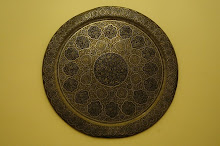The 20th century has contributed more than its share of political strongmen idolized in propaganda art. Lenin, Mao and Kim Il-Sung are just a few examples of these powerful and enduring cults of personality.
The Middle East, with its strong tradition of authority figures and periodic flights of ideology, has never been an exception to this tendency towards leader-worship. Travel to any country in the region and you will come face-to-face with these omnipresent images of "the leader”, often staring down from the inside of coffee shops, airport lounges, customs posts, offices - or from along roadsides or the exteriors of buildings.
These images, which include photographs, are often less stylized than the colourful, dramatic and grandiose propaganda images born of the big Communist countries of last century (Qaddafi, Saddam and the Ayatollahs excepted).
Drawing on older, more flattering poses struck in their youth, the images ironically come off at times as somewhat bland and unimaginative. Some past examples: a late 80s Hosni Mubarak trying to his best to hold a fine-tuned, friendly smirk; Jordan’s King Hussein beaming from under a red checkered keffiya; and Hafez al-Assad, leaning forward with a disarming grin meant to belie his legendary stubbornness and brutality.
But outdoing them all, seemingly without effort, is the man whose cult of personality outlasted all others: Turkey’s Mustafa Kemal Atatürk.
Atatürk, who was the founder of the Turkish Republic, has long been treated with godlike reverence by many of his co-nationals. A turn-of-the-century Ottoman officer turned revolutionary, Atatürk seized power after the Ottoman defeat of World War One, beat back the remnants of occupying armies, and declared Turkish Independence in 1923. He then embarked on a program of political, economic, and cultural reforms meant to transform Turkey into a modern, secular, and democratic country. He remained in office until his death in 1938.
A few years before he died Turkey's parliament granted Mustafa Kemal the surname “Atatürk” (meaning "Father of the Turks"). By the same decree, the name was forbidden to any other person in the country. Ever since his passing, any perceived slight or insult toward the man was liable to be met with arrest and imprisonment.
Whatever one thinks of him (he had, and still has numerous detractors), many Turks still see him as a kind of godman whose accomplishments represent an inviolable pinnacle never to be superceded or reversed. And with such cults of worship come the visual trappings meant to evoke emotion among the populace.
Like his counterparts in neighbouring Middle Eastern countries, his pictures and statues grace every open space. Atatürk’s no-nonsense air of steely determination buttressed by good looks, sophistication and self-confidence stand out from the images of his Middle Eastern counterparts - past or present - who often appear insecure or bombastic in their attempts to charm their populations.
Perhaps the images of Mustafa Kemal Atatürk reveal a man of a different mettle? And if so, one wonders what he would have thought of Turkey’s deification of both his character, and ideas?
The elevation of an authority figure to the status of a virtual god, not only plays upon the dependency wishes of individuals, but is also designed to help keep the masses controlled and easily mobilized in their internal and external struggles against the “other”. Where such idols thrive, there also exists the widespread problem of fixed thinking.
While Atatürk’s cult may be in decline today due to the continued rise of political Islam, and while some Arabs have awoken to the need to tear down their own political idols, the tendency by cultures in the region to revere authority figures as protective, all-knowing, parents remains very much a reality.


















